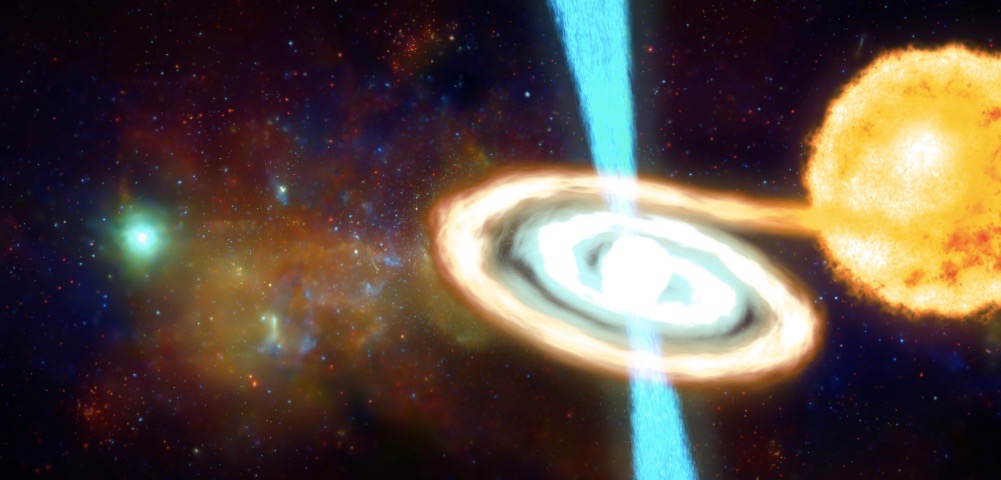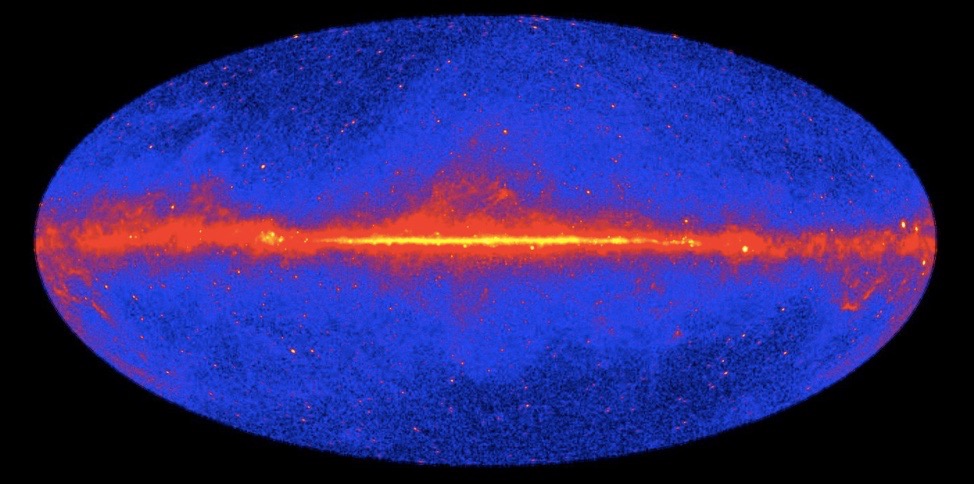
A promising lead about the nature of elusive dark matter may have just dried up.
A mysterious abundance of gamma-rays — the highest-energy light in the universe — at the Milky Way's center is likely being produced by fast-spinning stellar corpses called pulsars, rather than bits of dark matter slamming into each other, a new study suggests.
"Our study shows that we don’t need dark matter to understand the gamma-ray emissions of our galaxy,” co-author Mattia Di Mauro, from the Kavli Institute for Particle Astrophysics and Cosmology (KIPAC) in California, said in a statement. [The Hunt for Dark Matter: Images and Photos]
"Instead, we have identified a population of pulsars in the region around the galactic center, which sheds new light on the formation history of the Milky Way," added Di Mauro, who led the analysis for the Fermi LAT Collaboration. This is a group of researchers who used the Large Area Telescope on NASA's Fermi Gamma-ray Space Telescope to study the galaxy's gamma-ray glow.

Hunting for dark matter

Though dark matter apparently neither emits nor absorbs light (hence the name), astronomers know the stuff exists; they have observed its gravity affecting the "normal" matter we can see and touch. Indeed, such work suggests that dark matter makes up about 85 percent of the material universe.
However, scientists still don't know what the mysterious stuff is. One leading hypothesis holds that dark matter is composed mostly of Weakly Interacting Massive Particles (WIMPs). Theoretical physicists think that WIMPs generate gamma-rays when they interact with each other, either via direct annihilation or the production of a fast-decaying secondary particle.
So it was exciting when, several years ago, Fermi spotted an "excess" of gamma-rays near the Milky Way's core that astronomers said could not be explained by traditional sources such as pulsars. Process of elimination seemed to indicate that dark matter — in the form of WIMPs — was responsible.
Sign up for the Live Science daily newsletter now
Get the world’s most fascinating discoveries delivered straight to your inbox.
The researchers behind such studies stressed at the time that this interpretation was tentative and in need of backing by other observations.
Pulsars the culprit?
Such confirmation has yet to materialize.
"Two recent studies by teams in the U.S. and the Netherlands have shown that the gamma-ray excess at the galactic center is speckled, not smooth as we would expect for a dark matter signal," KIPAC's Eric Charles, who contributed to the new analysis, said in the same statement.
"Those results suggest the speckles may be due to point sources that we can't see as individual sources with the LAT because the density of gamma-ray sources is very high and the diffuse glow is brightest at the galactic center," Charles added.
The new study further supports this idea, linking the speckled signal to pulsars.
"Considering that about 70 percent of all [gamma-ray] point sources in the Milky Way are pulsars, they were the most likely candidates," Di Mauro said. "But we used one of their physical properties to come to our conclusion. Pulsars have very distinct spectra — that is, their emissions vary in a specific way with the energy of the gamma-rays they emit. Using the shape of these spectra, we were able to model the glow of the galactic center correctly with a population of about 1,000 pulsars and without introducing processes that involve dark matter particles."
There are other reasons to doubt that the gamma-ray excess is being generated by dark matter, study team members said.
"If the signal were due to dark matter, we would expect to see it also at the centers of other galaxies," Seth Digel, head of KIPAC’s Fermi group, said in the same statement. "The signal should be particularly clear in dwarf galaxies orbiting the Milky Way. These galaxies have very few stars, typically don’t have pulsars and are held together because they have a lot of dark matter. However, we don't see any significant gamma-ray emissions from them."
The team plans to observe the Milky Way's center with radio telescopes, in an attempt to determine if the point sources there are emitting their light in pulses, as pulsars seem to do. (This is just an illusion, however. Pulsars emit light beams continuously in opposite directions; the light appears to flicker because pulsars spin, and their beams are therefore not always pointing at Earth.)
The new study has been submitted to The Astrophysical Journal. You can read it for free at the online preprint site arXiv.org.
Follow Mike Wall on Twitter @michaeldwall and Google+. Follow us @Spacedotcom, Facebook or Google+. Originally published on Space.com.











